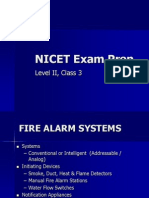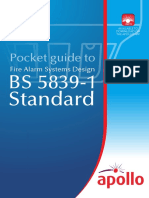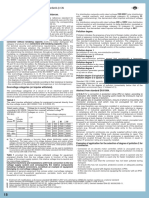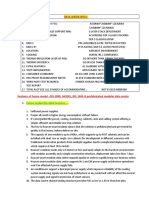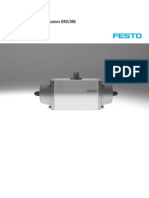Fire Alarm Sys Nec 760
Fire Alarm Sys Nec 760
Uploaded by
nadeem UddinCopyright:
Available Formats
Fire Alarm Sys Nec 760
Fire Alarm Sys Nec 760
Uploaded by
nadeem UddinOriginal Description:
Copyright
Available Formats
Share this document
Did you find this document useful?
Is this content inappropriate?
Copyright:
Available Formats
Fire Alarm Sys Nec 760
Fire Alarm Sys Nec 760
Uploaded by
nadeem UddinCopyright:
Available Formats
ARTICLE
760 FIRE ALARM SYSTEMS
Introduction to Article 760—Fire Alarm Systems
Article 760 covers the installation of wiring and equipment for fire alarm systems, including circuits controlled and powered
by the fire alarm. These include fire detection and alarm notification, guard’s tour, sprinkler waterflow, and sprinkler supervi-
sory systems. NFPA 72, National Fire Alarm Code provides other fire alarm system requirements.
Part I. General Author’s Comment:
n Residential smoke alarm systems, including interconnect-
760.1 Scope ing wiring, aren’t covered by Article 760, because they aren’t
powered by a fire alarm system as defined in NFPA 72.
Article 760 covers the installation of wiring and equipment for fire
alarm systems, including circuits controlled and powered by the fire Note 1: Fire alarm systems include fire detection and alarm notifi-
cation, guard’s tour, sprinkler waterflow, and sprinkler supervisory
alarm system. Figure 760–1
systems. Other circuits that might be controlled or powered by the fire
alarm system include elevator capture, elevator shutdown, door release,
smoke doors and damper control, fire doors and damper control, and fan
shutdown.
NFPA 72, National Fire Alarm and Signaling Code, provides the require-
ments for the selection, installation, performance, use, testing, and
maintenance of fire alarm systems.
Author’s Comment:
n Building control circuits associated with the fire alarm
system, such as elevator capture and fan shutdown, must
comply with Article 725 [760.3(E)]. Article 760 applies if
these components are powered and directly controlled by the
fire alarm system.
n NFPA 101—Life Safety Code or the local building code spec-
Figure 760–1 ifies when and where a fire alarm system is required.
FREE PDF—Fire Alarm Systems 2014 NEC www.MikeHolt.com
3 | 888.NEC.CODE (632.2633)
Article 760 | Fire Alarm Systems
760.2 Definitions
Abandoned Fire Alarm Cable. A cable that isn’t terminated to equip-
ment and not identified for future use with a tag.
Author’s Comment:
n Section 760.25 requires the accessible portion of abandoned
cables to be removed.
Fire Alarm Circuit. The portion of the wiring system and connected
equipment powered and controlled by the fire alarm system. Fire alarm
circuits are classified as either nonpower-limited or power-limited.
Nonpower-Limited Fire Alarm Circuit. A nonpower-limited fire alarm
Figure 760–3
circuit can operate at up to 600V, and the power output isn’t limited
[760.41 and 760.43]. Figure 760–2
Not Inherently Limited [Chapter 9, Table 12(A)]
Overcurrent Voltage Power Protection
0V to 20V 5.00 x V 5A
21V to 100V 100 VA 100/V
101V to 150V 100 VA 1A
Author’s Comment:
n Inherently limited power supplies are designed to burn out if
overloaded.
760.3 Other Articles
Figure 760–2
Only those sections of Article 300 specifically referenced in this arti-
cle apply to fire alarm systems, and fire alarm circuits and equipment
Power-Limited Fire Alarm Circuit. A power-limited fire alarm circuit must comply with (A) through (G) as follows:
must have the voltage and power limited by a listed power supply that
complies with 760.121 as follows: Figure 760–3 (A) Spread of Fire or Products of Combustion. Fire alarm circuits
installed through fire-resistant-rated walls, partitions, floors, or ceil-
ings must be firestopped to limit the possible spread of fire or products
Inherently Limited (ac) [Chapter 9, Table 12(A)] of combustion in accordance with the instructions supplied by the
Voltage Power manufacturer for the specific type of cable and construction material
(drywall, brick, and so forth) [300.21]. Figure 760–4
0V to 20V 5.00 x V
21V to 100V 100 VA
FREE PDF—Fire Alarm Systems 2014 NEC www.MikeHolt.com
4 | 888.NEC.CODE (632.2633)
Article 760 | Fire Alarm Systems
Figure 760–4 Figure 760–5
(D) Corrosive, Damp, or Wet Locations. Fire alarm circuits installed
Question: How many 18 TFFN fixture wires can be installed in
in corrosive, damp, or wet locations must be identified for use in the
trade size ½ electrical metallic tubing? Figure 760–6
operating environment [110.11], must be of materials suitable for the
environment in which they’re to be installed, and must be of a type (a) 22 (b) 26 (c) 30 (d) 40
suitable for the application [300.5(B), 300.6, 300.9, and 310.10(G)]. Answer: (a) 22 conductors [Annex C, Table C.1]
(E) Building Control Circuits. Class 1, 2, and 3 circuits used for build-
ing controls (elevator capture, fan shutdown, and so on), associated
with the fire alarm system, but not controlled and powered by the fire
alarm system, must be installed in accordance with Article 725 [760.1].
(F) Optical Fiber Cables. Optical fiber cables utilized for fire alarm cir-
cuits must be installed in accordance with Article 770.
(H) Raceways or Sleeves Exposed to Different Temperatures. If a
raceway or sleeve is subjected to different temperatures, and where
condensation is known to be a problem, the raceway or sleeve must
be filled with a material approved by the authority having jurisdic-
tion that will prevent the circulation of warm air to a colder section
of the raceway. An explosionproof seal isn’t required for this purpose
[300.7(A)]. Figure 760–5
(J) Number and Size of Conductors in a Raceway. Raceways must
be large enough to permit the installation and removal of conductors
without damaging conductor insulation [300.17]. Figure 760–6
Author’s Comment:
n When all conductors in a raceway are the same size and (K) Bushing. When a raceway is used for the support or protection of
insulation, the number of conductors permitted can be found cables, a bushing to reduce the potential for abrasion must be placed
in Annex C for the raceway type. at the location where the cables enter the raceway in accordance with
300.15(C). Figure 760–7
FREE PDF—Fire Alarm Systems 2014 NEC www.MikeHolt.com
5 | 888.NEC.CODE (632.2633)
Article 760 | Fire Alarm Systems
Figure 760–7 Figure 760–8
760.21 Access to Electrical Equipment
Behind Panels Designed to Allow Access
Access to equipment must not be prohibited by an accumulation of
cables that prevent the removal of suspended-ceiling panels.
Author’s Comment:
n Cables must be located so that the suspended-ceiling panels
can be moved to provide access to electrical equipment.
760.24 Mechanical Execution of Work
Figure 760–9
(A) General. Equipment and cabling must be installed in a neat and
workmanlike manner.
Cables installed through or parallel to framing members or furring
Exposed cables must be supported by the structural components of strips must be protected where they’re likely to be penetrated by nails
the building so that the cable won’t be damaged by normal build- or screws, by installing the wiring method so it isn’t less than 1¼ in.
ing use. Cables must be supported by straps, staples, hangers, cable from the nearest edge of the framing member or furring strips, or
ties, or similar fittings designed and installed in a manner that won’t by protecting them with a 1⁄16 in. thick steel plate or the equivalent
damage the cable. Figure 760–8 [300.4(D)]. Figure 760–10
Author’s Comment:
n Raceways and cables above a suspended ceiling must be
supported by independent support wires attached to the sus-
pended ceiling [300.11(A), 760.46, and 760.130]. Figure
760–9
FREE PDF—Fire Alarm Systems 2014 NEC www.MikeHolt.com
6 | 888.NEC.CODE (632.2633)
Article 760 | Fire Alarm Systems
Figure 760–10 Figure 760–12
Author’s Comment:
760.25 Abandoned Cable n Cables installed in concealed raceways aren’t considered
“accessible”; therefore, they’re not required to be removed.
To limit the spread of fire or products of combustion within a build-
ing, the accessible portion of cable that isn’t terminated at equipment
and not identified for future use with a tag must be removed [760.2]. 760.30 Fire Alarm Circuit Identification
Figure 760–11
Fire alarm circuits must be identified at terminal and junction locations.
The identification must be in such a manner that will help to prevent
unintentional signals on the fire alarm system circuits during testing
and servicing of other systems. Figure 760–13
Figure 760–11
Cables identified for future use must be with a tag that can withstand
the environment involved. Figure 760–12
Figure 760–13
FREE PDF—Fire Alarm Systems 2014 NEC www.MikeHolt.com
7 | 888.NEC.CODE (632.2633)
Article 760 | Fire Alarm Systems
The location of the branch-circuit overcurrent device for the
760.32 Fire Alarm Circuit Cables power-limited fire alarm equipment must be permanently identified at
Extending Beyond a Building the fire alarm control unit. Figure 760–15
If fire alarm circuit conductors extend beyond a building and run out-
doors, they must be installed in accordance with Parts II, III, and IV of
Article 800, and they must also be installed in accordance with Part I
of Article 300.
760.35 Fire Alarm Circuit Requirements
(A) Nonpower-Limited Fire Alarm Circuits. Nonpower-limited fire
alarm (NPLFA) circuits must comply with Parts I and II of this article.
(B) Power-Limited Fire Alarm Circuits. Power-limited fire alarm
(PLFA) circuits must comply with Parts I and III of this article.
Part III. Power-Limited Fire Alarm Figure 760–15
(PLFA) Circuits
The branch-circuit overcurrent device must be identified in red, acces-
760.121 Power Sources for sible only to qualified personnel, and identified as “FIRE ALARM
Power-Limited Fire Alarm Circuits CIRCUIT.” The red identification must not damage the overcurrent pro-
tective device or obscure any manufacturer’s markings. Figure 760–16
(B) Branch Circuit. Power-limited fire alarm equipment must be sup-
plied by a branch circuit that supplies no other load and isn’t GFCI or
AFCI protected. Figure 760–14
Figure 760–16
Figure 760–14
FREE PDF—Fire Alarm Systems 2014 NEC www.MikeHolt.com
8 | 888.NEC.CODE (632.2633)
Article 760 | Fire Alarm Systems
Author’s Comment:
760.124 Equipment Marking
n Exposed cables must be supported by the structural com-
ponents of the building so the cable won’t be damaged by
Fire alarm equipment supplying power-limited fire alarm cable circuits
normal building use. Cables must be secured by straps, sta-
must be durably marked to indicate each circuit that’s a power-limited
ples, hangers, or similar fittings designed and installed in
fire alarm circuit.
a manner that won’t damage the cable. Cables installed
through or parallel to framing members or furring strips must
Author’s Comment:
be protected where they’re likely to be penetrated by nails or
n Fire alarm circuits must be marked at terminal and junction screws, by installing the wiring method so it isn’t less than
locations [760.30]. 1¼ in. from the nearest edge of the framing member or fur-
ring strips, or it must be protected by a 1⁄16 in. thick steel
plate or the equivalent [760.24(A)].
760.130 Wiring Methods on Load Side of
Power-Limited Fire Alarm Power Source
760.135 Installation of PLFA
(B) PLFA Wiring Methods and Materials. Power-limited fire alarm Cables in Buildings
conductors and cables described in 760.179 must be installed as
detailed in (1), (2), or (3) of this section and 300.7. Installation of power-limited fire alarm cables in buildings must comply
(1) Exposed or Fished in Concealed Spaces. Cable splices or termi- with 760.135(A) through (J).
nations must be made in listed fittings, boxes, enclosures, fire alarm (A) Listing. PLFA cables installed in buildings must be listed.
devices, or utilization equipment. Figure 760–17
(C) Plenum Spaces. Plenum rated FPLP cables are permitted in
plenum spaces as described in 300.22(C). Figure 760–18
Figure 760–17
Figure 760–18
Power-limited fire alarm cable installed exposed must be adequately
supported and protected against physical damage.
(H) Other Building Locations. The following cables are permitted to
be installed in building locations other than the locations covered in
770.113(B) through (H):
FREE PDF—Fire Alarm Systems 2014 NEC www.MikeHolt.com
9 | 888.NEC.CODE (632.2633)
Article 760 | Fire Alarm Systems
(1) Types FPLP, FPLR, and FPL cables
(2) Types FPLP, FPLR, and FPL cables installed in:
a. Plenum communications raceways
b. Plenum cable routing assemblies
c. Riser communications raceways
d. Riser cable routing assemblies
e. General-purpose communications raceways
f. General-purpose cable routing assemblies
(3) Types FPLP, FPLR, and FPL cables installed in a raceway of a type
recognized in Chapter 3
Figure 760–19
760.136 Separation from
Power Conductors
760.139 Power-Limited Fire Alarm
(A) General. Power-limited fire alarm conductors must not be placed
Circuits, Class 2, Class 3, and
in any enclosure, raceway, or cable with conductors of electric light, Communications Circuits
power, or Class 1 circuits.
(A) Two or More PLFA Circuits. Power-limited fire alarm circuits,
(B) Separated by Barriers. If separated by a barrier, power-limited fire
communications circuits, or Class 3 circuits can be in the same cable,
alarm circuits are permitted with electric power conductors.
enclosure, cable tray, raceway, or cable routing assembly. Figure
Author’s Comment: 760–20
n Separation is required to prevent a fire or shock hazard that
can occur from a short between the fire alarm circuit and the
higher-voltage circuits.
(D) Associated Systems Within Enclosures. Power-limited fire alarm
conductors can be mixed with electric light, power, and Class 1 circuit
conductors in enclosures where these other conductors are introduced
solely for connection to the same equipment, and:
(1) A minimum of ¼ in. separation is maintained from the power-
limited fire alarm cable conductors.
(G) Other Applications. Power-limited fire alarm circuit conductors
must be separated by not less than 2 in. from insulated conductors of
electric light, power, or Class 1 circuits unless:
(1) Electric light, power, Class 1 circuit conductors, or power-limited
fire alarm circuit conductors, are in a raceway or in metal-sheathed, Figure 760–20
metal-clad, nonmetallic-sheathed, or underground feeder cables.
Figure 760–19
FREE PDF—Fire Alarm Systems 2014 NEC www.MikeHolt.com
10 | 888.NEC.CODE (632.2633)
Article 760 | Fire Alarm Systems
(B) PLFA and Class 2 Circuits. Class 2 circuits can be within the
same cable, cable routing assembly, enclosure, cable tray, or race-
way as conductors of power-limited fire alarm circuits provided the
Class 2 circuit conductor insulation isn’t less than that required for the
power-limited fire alarm circuits.
Author’s Comment:
n Listed Class 2 cables have an insulation voltage rating of at
least 150V [725.179(G)], whereas listed power-limited fire
alarm cables have a voltage rating of not less than 300V
[760.179(C)].
(D) Audio System Circuits and Power-Limited Fire Alarm Circuits.
Audio system circuits [640.9(C)] using Class 2 or Class 3 wiring meth-
ods [725.133 and 725.154] must not be installed in the same cable, Figure 760–21
cable routing assembly, cable tray, or raceway with power-limited fire
alarm conductors or cables.
Author’s Comment:
n The concern is that a fault from audio amplifier circuits to
fire alarm circuits has the potential to create a hazard by dis-
rupting the operation of fire alarm systems. However, this
restriction doesn’t apply to the voice annunciation audio
circuits supplied and controlled from a fire alarm panel
and commonly required in high-rise buildings and similar
applications.
760.143 Support
Figure 760–22
Power-limited fire alarm cables aren’t permitted to be strapped, taped,
or attached to the exterior of any raceway as a means of support.
Figure 760–21
760.154 Applications of Power-Limited
Fire Alarm Cables (PLFA)
PLFA cables must meet the requirements of Table 760.154, or the sub-
stitutions allowed in 760.154(A). Figure 760–22
FREE PDF—Fire Alarm Systems 2014 NEC www.MikeHolt.com
11 | 888.NEC.CODE (632.2633)
Article 760 | Fire Alarm Systems
Part IV. Listing Requirements
760.179 Listing and Marking of
Power-Limited Fire Alarm Cables (PLFA)
PLFA cable installed within buildings must be listed as being resistant
to the spread of fire and other criteria in accordance with 760.179(A)
through (H) and shall be marked in accordance with 760.179 (I).
(C) Ratings. Fire Alarm cable must have a voltage rating of not less
than 300 volts. Figure 760–23
(D) Type FPLP. Type FPLP plenum cable is listed as being suitable for
use in plenum space. Figure 760–24
(I) Marking. Cables must be marked in accordance with Figure 760–23
Table760.179(I). Voltage ratings are not permitted to be marked on the
cable.
Note: Voltage markings on cables may suggest that the cables are suit-
able for Class 1 or electric power and light applications, which they are
not.
Figure 760–24
FREE PDF—Fire Alarm Systems 2014 NEC www.MikeHolt.com
12 | 888.NEC.CODE (632.2633)
You might also like
- Comparison Between UL En-54Document1 pageComparison Between UL En-54boubress100% (5)
- Simplex 4100ES Programmers ManualDocument446 pagesSimplex 4100ES Programmers Manualsureshkanuboyina100% (2)
- Nicet Exam Prep Presentation Level II Class 3-1Document46 pagesNicet Exam Prep Presentation Level II Class 3-1ramkrishna100% (1)
- Nfpa - BS - Ul - LPCBDocument48 pagesNfpa - BS - Ul - LPCBmusleh1986% (7)
- Data Centers - Nfpa 72 2022 PDFDocument74 pagesData Centers - Nfpa 72 2022 PDFMichel Corrêa100% (2)
- FK 5-1-12 Design ManualDocument140 pagesFK 5-1-12 Design ManualRoberto DiazNo ratings yet
- Nfpa 72 2022Document3 pagesNfpa 72 2022Franklin Lozano50% (2)
- Apollo Fire Alarm Design Guide PDFDocument100 pagesApollo Fire Alarm Design Guide PDFlima muslih100% (3)
- 2008 NEC Article 760Document10 pages2008 NEC Article 760Rafael Rodriguez100% (3)
- Novec 1230 BoqDocument1 pageNovec 1230 Boqaneesh0% (1)
- Siemens Gas Turbine SGT6-5000FDocument32 pagesSiemens Gas Turbine SGT6-5000Fkeplerjuan86% (7)
- Pocket Fire Alarm Design and Installation GuideDocument46 pagesPocket Fire Alarm Design and Installation Guideadam rejamNo ratings yet
- NFPA 72 - National Fire Alarm CodeDocument32 pagesNFPA 72 - National Fire Alarm Codetarottaurus549254100% (4)
- R-102 Manual PDFDocument141 pagesR-102 Manual PDFphibet86% (7)
- Kidde FM200-Manual PDFDocument116 pagesKidde FM200-Manual PDFredvalor100% (1)
- A Guide To Fire Alarm System Design BS 5839 Part 1 2002Document20 pagesA Guide To Fire Alarm System Design BS 5839 Part 1 2002s525497100% (2)
- How To Use The NEC-Mike HoltDocument3 pagesHow To Use The NEC-Mike HoltJOSE LUIS FALCON CHAVEZ100% (2)
- Cargo Oil Pump TurbineDocument16 pagesCargo Oil Pump TurbineNikolay KirovNo ratings yet
- Common Code Requirements For Fire Alarm Systems (1996)Document88 pagesCommon Code Requirements For Fire Alarm Systems (1996)shaun110100% (1)
- Fire Alarm CablesDocument27 pagesFire Alarm Cablespigulus100% (2)
- Advanced Fire Training - 8700055 - REV D - 10/07Document32 pagesAdvanced Fire Training - 8700055 - REV D - 10/07mastersaiz100% (2)
- FACP, Presentation Level II Class 3Document46 pagesFACP, Presentation Level II Class 3Salley BukhariNo ratings yet
- A Practical Guide To Fire Alarm SystemsDocument70 pagesA Practical Guide To Fire Alarm SystemsAhmadJefniJaafar100% (2)
- NTC Book FlyerDocument1 pageNTC Book FlyerRob JanousekNo ratings yet
- Fire Alarm Installation GuideDocument44 pagesFire Alarm Installation GuideRahul SrivastavaNo ratings yet
- Fire AlarmDocument24 pagesFire Alarmbsh1978100% (2)
- Fire Alarm TerminologyDocument50 pagesFire Alarm Terminologyfakharkhilji100% (2)
- NTC Nicet ReviewerDocument132 pagesNTC Nicet ReviewerJerick JavelosaNo ratings yet
- Nfpa 72 Device InstallationDocument1 pageNfpa 72 Device Installationoye74No ratings yet
- Fire Alarm Systems 2017NECDocument14 pagesFire Alarm Systems 2017NECDomingo Ruiz100% (1)
- BS & en 54Document4 pagesBS & en 54shashi ranjan100% (1)
- Fire Alarm Training ManualDocument34 pagesFire Alarm Training Manualsossie100% (9)
- Notifier Little Black BookDocument76 pagesNotifier Little Black BookAdsventure TreseNo ratings yet
- Fire Alarm System Design StandardsDocument23 pagesFire Alarm System Design StandardsAlbert Tuazon100% (4)
- STANDARD 14.7.3 Fire Protection Systems Installation of Fire AlarmsDocument8 pagesSTANDARD 14.7.3 Fire Protection Systems Installation of Fire AlarmsMohd SayutiNo ratings yet
- Fire Alarm CablesDocument26 pagesFire Alarm CablesTS80% (5)
- BS 5266-1 Pocket Guide To Emergency LightingDocument21 pagesBS 5266-1 Pocket Guide To Emergency Lightingmir sadat ali100% (2)
- Fire Alarm System GuideDocument272 pagesFire Alarm System GuideNazeeruddin Mohammed92% (25)
- Battery Calculations For Fire Alarm and Signaling Systems - SFPEDocument3 pagesBattery Calculations For Fire Alarm and Signaling Systems - SFPEUri BabaNo ratings yet
- Ansul R-102 ManualDocument215 pagesAnsul R-102 ManualIvana NovitaNo ratings yet
- Interfacing Fire Alarm and ElevatorsDocument76 pagesInterfacing Fire Alarm and ElevatorsFrancisco M. Ramos100% (2)
- Intro To Basic Fire AlarmDocument160 pagesIntro To Basic Fire AlarmJulio Guerrero Casados100% (5)
- NFPA - Fire Alarm Sysyem Check ListDocument1 pageNFPA - Fire Alarm Sysyem Check ListDarkmatter DarkmatterrNo ratings yet
- Top 101 Rules NEC Part 1Document51 pagesTop 101 Rules NEC Part 1William100% (6)
- Fire Alarm SystemDocument41 pagesFire Alarm SystemShailendra SinghNo ratings yet
- Ansul Inergen ManualDocument0 pagesAnsul Inergen ManualShanmuga Raja100% (2)
- What To Know About The 2022 Edition of NFPA 72 Consulting - Specifying EngineerDocument1 pageWhat To Know About The 2022 Edition of NFPA 72 Consulting - Specifying EngineerAbdelrahman Mohamed100% (1)
- Fire Alarm Notes BS5839Document7 pagesFire Alarm Notes BS5839amintawkNo ratings yet
- Advanced Fire TrainingDocument34 pagesAdvanced Fire Trainingganeshakce100% (2)
- Sapphire Manual PN570590Document101 pagesSapphire Manual PN570590FitflowPeruNo ratings yet
- Xtralis VESDA Pipe Network Design Guide: Document Number: 10193 - 06 Part Number: 30009Document48 pagesXtralis VESDA Pipe Network Design Guide: Document Number: 10193 - 06 Part Number: 30009karma c. lepchaNo ratings yet
- Manual VESDADocument36 pagesManual VESDADanilo Pizarro ColoméNo ratings yet
- Multipole Connectors: Standards CNDocument1 pageMultipole Connectors: Standards CNDan PariascaNo ratings yet
- 5560A Speng0200Document32 pages5560A Speng0200laboratorioNo ratings yet
- 5560A Speng0100 0Document30 pages5560A Speng0100 0Juan RomeroNo ratings yet
- 9.18 Lightning and Surge Protection For PV Systems and Solar Power PlantsDocument10 pages9.18 Lightning and Surge Protection For PV Systems and Solar Power PlantsMaikel Torres RamirezNo ratings yet
- WOB Solar Power Product Solutions Guide BrochureDocument21 pagesWOB Solar Power Product Solutions Guide Brochurevineets058No ratings yet
- White Paper: Lightning and Surge Protection For Free Field PV Power PlantsDocument16 pagesWhite Paper: Lightning and Surge Protection For Free Field PV Power PlantsasotozuazuaNo ratings yet
- HV Chap10Document18 pagesHV Chap10supun100% (1)
- Chapter9 18 PDFDocument9 pagesChapter9 18 PDFsalem BEN MOUSSANo ratings yet
- Arc Fault Protection System REA 10 - : Product GuideDocument32 pagesArc Fault Protection System REA 10 - : Product GuideAlbertoNo ratings yet
- Dawadmi 700-Specs Vol1Document280 pagesDawadmi 700-Specs Vol1nadeem UddinNo ratings yet
- Deep Breathing TechniquesDocument1 pageDeep Breathing Techniquesnadeem UddinNo ratings yet
- Pages From ECBC-CodeDocument16 pagesPages From ECBC-Codenadeem UddinNo ratings yet
- Fire Alarm Sys - Installation ChecklistDocument1 pageFire Alarm Sys - Installation Checklistnadeem UddinNo ratings yet
- Active Doc ListDocument405 pagesActive Doc Listnadeem UddinNo ratings yet
- Comparison Sheet of Fusion ModelDocument3 pagesComparison Sheet of Fusion Modelnadeem UddinNo ratings yet
- SLD of DBDocument1 pageSLD of DBnadeem UddinNo ratings yet
- Data Center Tier RequirementsDocument1 pageData Center Tier Requirementsnadeem UddinNo ratings yet
- Data Center RequirementsDocument3 pagesData Center Requirementsnadeem Uddin100% (1)
- Cable Sizing Rev.3Document13 pagesCable Sizing Rev.3nadeem UddinNo ratings yet
- Types of Contactor For StarterDocument1 pageTypes of Contactor For Starternadeem UddinNo ratings yet
- G S 004Document1 pageG S 004nadeem UddinNo ratings yet
- Ms Glanding & Termination of LV CablesDocument18 pagesMs Glanding & Termination of LV Cablesnadeem UddinNo ratings yet
- TransTig 1750 Puls PDFDocument88 pagesTransTig 1750 Puls PDFDallas WilsonNo ratings yet
- Módulo Ponte H VNH 5019Document38 pagesMódulo Ponte H VNH 5019Kamylla C. OliveiraNo ratings yet
- Reheat Cracking-A Review of Recent StudiesDocument31 pagesReheat Cracking-A Review of Recent Studiesagilan89No ratings yet
- Brouwer NotesDocument255 pagesBrouwer NotesCannot SleepNo ratings yet
- EarthingDocument10 pagesEarthingHarsha Vardhan ReddyNo ratings yet
- iPowerCube R4875G5 Rectifier Datasheet 02 - (20190328)Document3 pagesiPowerCube R4875G5 Rectifier Datasheet 02 - (20190328)Alaa MuhameedNo ratings yet
- Actuator DRD DREDocument35 pagesActuator DRD DRESandi AslanNo ratings yet
- Recovery, Recrystallization, and Grain GrowthDocument12 pagesRecovery, Recrystallization, and Grain GrowthstevenwhittlNo ratings yet
- 2024 Feng Shui Guide - Maybank CAT7 20 January 2024Document32 pages2024 Feng Shui Guide - Maybank CAT7 20 January 2024Ooi Ban JuanNo ratings yet
- @@@ Geothermal-WellsDocument44 pages@@@ Geothermal-WellsstarykltNo ratings yet
- Electrical Science Manual 2023Document55 pagesElectrical Science Manual 2023ANSHUL SINGHNo ratings yet
- Tema DesignationDocument12 pagesTema Designationmohammadazrai0% (1)
- 2 Cafod Zimbabwe sg01514Document14 pages2 Cafod Zimbabwe sg01514lindachipwanya4No ratings yet
- Capsule House - Your Home, Your Way 4Document1 pageCapsule House - Your Home, Your Way 4ringo.roses1759No ratings yet
- 303-03 Engine Cooling 2.3L EcoBoost - Removal and Installation - Coolant Outlet ConnectorDocument12 pages303-03 Engine Cooling 2.3L EcoBoost - Removal and Installation - Coolant Outlet ConnectorCARLOS LIMADANo ratings yet
- Centrifugal Chiller - Fundamentals - Energy-ModelsDocument32 pagesCentrifugal Chiller - Fundamentals - Energy-Modelsmat_pranNo ratings yet
- Chapter 2rrDocument40 pagesChapter 2rrShen YenNo ratings yet
- Mohit K Patel ResumeDocument4 pagesMohit K Patel ResumeMohit PatelNo ratings yet
- Liberty Engine HistoryDocument124 pagesLiberty Engine HistoryCAP History Library100% (4)
- IrtmtcDocument668 pagesIrtmtcnripinthampanNo ratings yet
- Liquid Penetrant Testing Report: Sievert Emirates Inspection LLCDocument1 pageLiquid Penetrant Testing Report: Sievert Emirates Inspection LLCAvijit DebnathNo ratings yet
- Sample Exam 4 PDFDocument8 pagesSample Exam 4 PDFJdavidNo ratings yet
- Operation Manual: HT568388 EnglishDocument152 pagesOperation Manual: HT568388 EnglishVitaliyNo ratings yet
- For FinolexDocument72 pagesFor FinolexKokila KokilaNo ratings yet
- DTU, Department of Energy Engineering S in (KJ/ (KG K) ) - V in (M 3/kg) - T in (ºC) M.J. Skovrup & H.J.H Knudsen. 10-11-07 Ref:R.Döring. Klima+Kälte Ingenieur Ki-Extra 5, 1978Document1 pageDTU, Department of Energy Engineering S in (KJ/ (KG K) ) - V in (M 3/kg) - T in (ºC) M.J. Skovrup & H.J.H Knudsen. 10-11-07 Ref:R.Döring. Klima+Kälte Ingenieur Ki-Extra 5, 1978Willian SouzaNo ratings yet
- Ibanez, Ivan David S Bsed Sci 2B Lesson # 07 Solution Thermal ExpansionDocument6 pagesIbanez, Ivan David S Bsed Sci 2B Lesson # 07 Solution Thermal ExpansionAlvin Andante IbañezNo ratings yet
- Tax Equity Financing and Asset RotationDocument38 pagesTax Equity Financing and Asset RotationShofiul HasanNo ratings yet






















